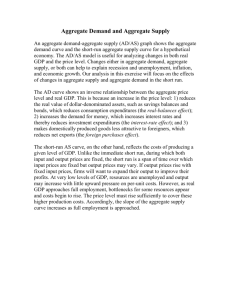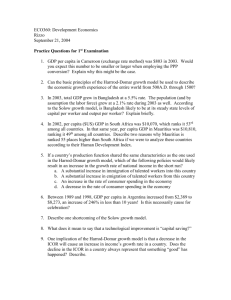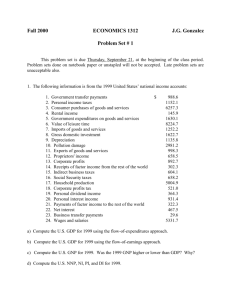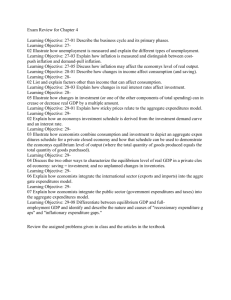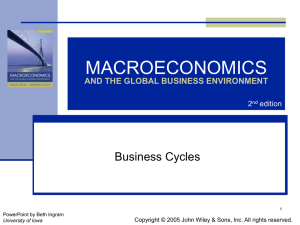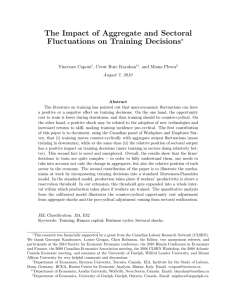economic growth and development
advertisement
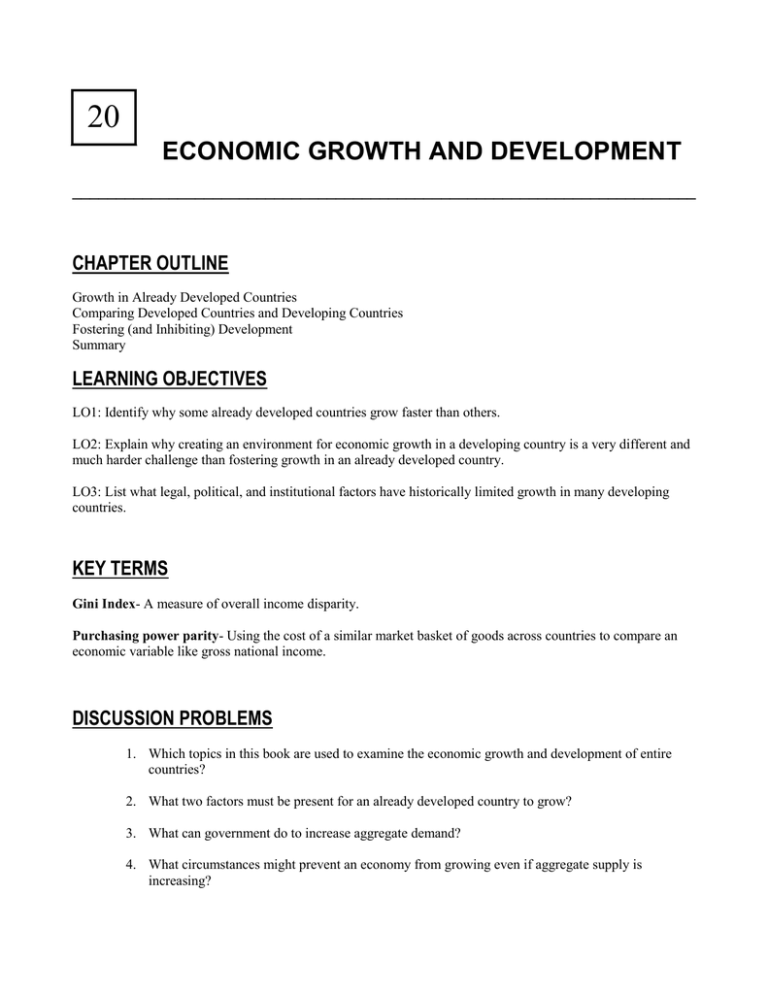
20 ECONOMIC GROWTH AND DEVELOPMENT _______________________________________________________________________ CHAPTER OUTLINE Growth in Already Developed Countries Comparing Developed Countries and Developing Countries Fostering (and Inhibiting) Development Summary LEARNING OBJECTIVES LO1: Identify why some already developed countries grow faster than others. LO2: Explain why creating an environment for economic growth in a developing country is a very different and much harder challenge than fostering growth in an already developed country. LO3: List what legal, political, and institutional factors have historically limited growth in many developing countries. KEY TERMS Gini Index- A measure of overall income disparity. Purchasing power parity- Using the cost of a similar market basket of goods across countries to compare an economic variable like gross national income. DISCUSSION PROBLEMS 1. Which topics in this book are used to examine the economic growth and development of entire countries? 2. What two factors must be present for an already developed country to grow? 3. What can government do to increase aggregate demand? 4. What circumstances might prevent an economy from growing even if aggregate supply is increasing? 308 Chapter 20 5. What is the usual determinant of economic growth in developed countries? 6. What fosters increase in aggregate supply? 7. What factor can increase aggregate supply without limit? 8. What two factors foster increases in worker productivity? 9. What is a Gini index and what does it mean? 10. What is purchasing power parity? 11. What is the central prediction of the Solow Growth model? 12. Why don’t the poorer countries grow faster than the richer ones, leading to fulfillment of the central prediction of the Solow Growth model? 13. What are repatriated profits? 14. What does nationalization of assets mean? 15. Why is an independent central bank important to developing countries? 16. What two East Asia countries have grown at a rather brisk pace during the past decade? 17. What are the basic building blocks for growing the economy of a poor country? Economic Growth and Development 309 THE WEB-BASED QUESTION Part I. Go to the website of the World Bank below, view the Overview of the Global Monitoring Report, 2008, and answer the questions below. http://siteresources.worldbank.org/INTGLOMONREP2008/Resources/47379941207342962709/8944_Web_PDF.pdf 1. What are the eight Millennium Development Goals of the World Bank? 2. Overall, how are countries faring in achieving these eight goals? 3. What link does the 2008 report highlight and what does the report conclude about this link? Part II. Go to the CIA’s 2007 World Factbook web page and fill in the data for the table below using the rank order pages. Follow the References – Guide to Countries Comparisons tabs. https://www.cia.gov/library/publications/the-world-factbook ITEM Lowest Ranking Country/Amount United States Amount Death Rate (per 1000 population) Infant Mortality Rate (per 1000 live births) Life Expectancy Rate (years) Unemployment Rate (%) Inflation Rate (%) GDP Per Capita (U.S. Dollars) GDP Real Growth Rate (%) Military Expenditures (percent of GDP) In what categories is the United States doing well? Not so well? World Amount Highest Ranking Country/Amount 310 Chapter 20 ANSWERS TO STUDY QUESTIONS DISCUSSION PROBLEMS 1. The study of economic growth and development draws upon (a) macroeconomics, (b) international trade, and (c) government policy. It also uses a little bit of guesswork, but, of course, this topic has not already been discussed in this book. 2. For a developed economy to grow, it needs two things: (a) sustained increases in aggregate demand and (b) a simultaneous sustained increase in aggregate supply. 3. Government can stimulate aggregate demand using fiscal (government spending and/or taxes) or monetary (money supply) policy. 4. Aggregate demand might not also increase due to deflationary pressures that diminish people’s willingness to buy big-ticket items. 5. Increases in aggregate supply ultimately come from increases in worker productivity. 6. Decreases in government regulation, decreases in input prices, and increases in worker productivity (education, tools, and technology) foster increases in aggregate supply. 7. Worker productivity can increase without limit, thereby increasing aggregate supply without limit. 8. Worker productivity is fostered by government policies that contribute to long-term capital formation and worker education and training. 9. The Gini index is a measure of overall income disparity. It is generally higher in poorer countries than richer. 10. Purchasing power parity is the practice of using the cost of a similar market basket of goods within different countries to compare macroeconomic variables, such as Gross Domestic Product. 11. The central prediction of the Solow Growth model is that the levels of economic development of the countries of the world should converge over time. That is, poorer countries should grow faster than richer ones to the point where their per capita real GDP would not differ that much. 12. Poorer countries do not grow faster than richer ones because they have so many obstacles that prevent them from doing so. These obstacles include (a) low rates of basic literacy, (b) lack of infrastructure, (c) political instability, (d) corruption, (e) lack of independent central banking, (f) inability to repatriate profits, and (g) the need to focus on the very basic necessities of life. 13. Repatriated profits are profits earned by a foreigner within a country that are converted into a hard currency (dollar, Euro, etc.) and exported out of that country. 14. An independent central bank is important to developing countries because without one, the country’s ruler(s) can print money to build palaces for themselves or pay soldiers for protection. 15. Assets are nationalized when a government confiscates or forcibly takes ownership of foreigners’ assets. Economic Growth and Development 311 16. China and South Korea have experienced vigorous growth during the past decade. 17. The basic building blocks for growing a poor country’s economy are (a) education, (b) low or manageable level of government corruption, and (c) a level of political and financial stability that creates confidence among foreign investors. SUGGESTED ANSWERS TO WEB-BASED QUESTIONS Part I. 1. The eight MDGs are reducing poverty and hunger, educating all children, empowering women, saving children, caring for mothers, combating disease, using resources wisely, and working together. 2. Overall, most countries will fall short of these goals. Prospects are gravest for the goals of reducing child and maternal mortality. Serious shortfalls also are likely in primary school completion, nutrition, and sanitation goals. 3. The report stresses the link between environment and development, and calls for urgent action on climate change. Part II. ITEM Death Rate (per 1000 population) Infant Mortality Rate (per 1000 live births) Life Expectancy Rate (years) Unemployment Rate (%) Inflation Rate (%) GDP Per Capita (U.S. Dollars) GDP Real Growth Rate (%) Military Expenditures (percent of GDP) Lowest Ranking Country/Amount United Arab Emirates 2.11 United States Amount 8.38 World Amount 8.20 Highest Ranking Country/Amount Swaziland 30.83 Singapore 2.31 6.26 40.85 Angola 180.21 Swaziland 31.88 78.11 66.57 Macau 84.36 Andorro (and others) 0.0 San Marino -3.5% Zimbabwe $200 Zimbabwe -12.6 7.2 30 4.2 N.A. $47,000 $10,400 1.3 3.8 Nauru 90 Zimbabwe 11.2 million Liechtenstein $118,000 Macau 15 4.06 2.0 Iceland 0.0 Oman 11.4 The United States appears do be doing well in every category except GDP real growth and military expenditures as a percent of GDP.



